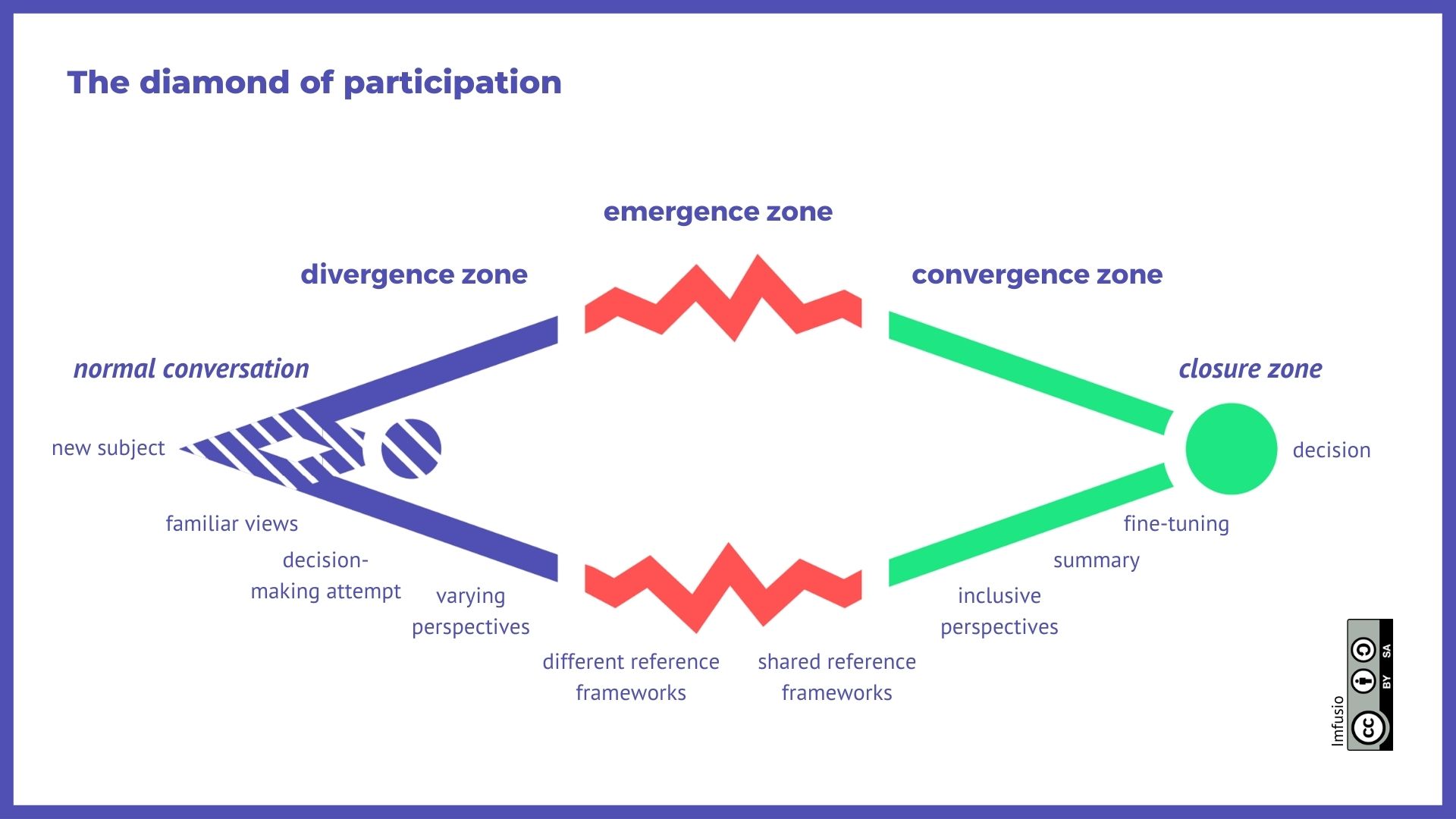To save colors and take care of the planet, print this text in shades of gray
The diamond of participation
Effectively structure a meeting or collective intelligence session
Théorie
Introduction
The diamond of participation represents the 3 main phases that constitute any good meeting or collective intelligence process. This group process map was created by American facilitator Sam Kaner in 1996.
In order to gain a better understanding of the group’s collective journey, whether this happens over the period of several months or during a simple work meeting, he thought that it was pertinent to identify the different phases a group goes through on the way to making a participatory decision.
Each phase plays its own part in bringing out the group’s collective intelligence, from sharing knowledge to coming up with ideas and putting them into action.
Description
- Divergence
This is the phase during which we explore a context, question, or concern, when all points of view are expressed and listened to. It’s a prerequisite for successfully making decisions and implementing actions that truly make sense within the relevant context and for the people affected.
This exploration phase must be long enough to generate enough ideas and different perspectives. If you cut it too short, essential contextual information and points of view will be missed, and the actions that result from the process will lack innovation and will only provide a partial solution to the problem.
- Emergence
Co-creation time. This phase is essential if we want to end up with responses, solutions or ideas that are both new and relevant.
Although incredibly useful, this phase is also the most turbulent, and the group may find themselves feeling uncomfortable, uncertain or impatient. This is the moment at which the participants might say, at the end of a brainstorming session for example, “And what now”?, “Are we wasting our time here?”, etc.
The emergence phase is also very aptly sometimes referred to as the “groan zone” AND the “grow zone”.
- Convergence
This is the time for solutions and actions. We sometimes have a habit of rushing towards this stage, as it’s always reassuring to aim for something concrete.
During this phase, you gather and sort all the ideas so that you can make a decision and/or implement an action plan that effectively incorporates all aspects of the topic you’ve just addressed together.
It gives the group the impetus to work both individually and collectively. It’s not “my idea” or “your idea”, but “our idea”!

Like for all collective intelligence processes, it’s important to come ready with a clear intention that can be used as a starting point, and to finish the session by sharing the results and planning out the next steps.
Example applications
Each of the three phases of the diamond must be facilitated by clear questions and methods that direct the discussions.
- Methods and tools for the divergence phase:
- Photo-language techniques, such as Vision-co
- World Café
- Bono’s 6 Thinking Hats (white, black, yellow)
- The “Five Whys”
- Methods and tools for the emergence phase:
- Bono’s 6 Thinking Hats (green hat)
- The Fish Bowl
- The Talking Circle
- Brainstorming
- Methods and tools for the convergence phase:
- All decision-making methods (cumulative voting, dotmocracy, majority vote, management by consent, election with no candidates.)
- Action plan: who’s doing what, when, how, etc.
- Methods and tools combining all three phases:
- The Open Forum
- Bono’s Six Thinking Hats
- The Pro Action Café
Tips and advice
During any collective intelligence process, it’s essential that you keep track of which phase you’re in, in order to set clear boundaries for each step and anticipate the potential reactions the participants may have at any moment: discomfort, impatience, inspiration, energy… The more aware you are of each step, the better you’ll be able to facilitate the group’s decision-making process.